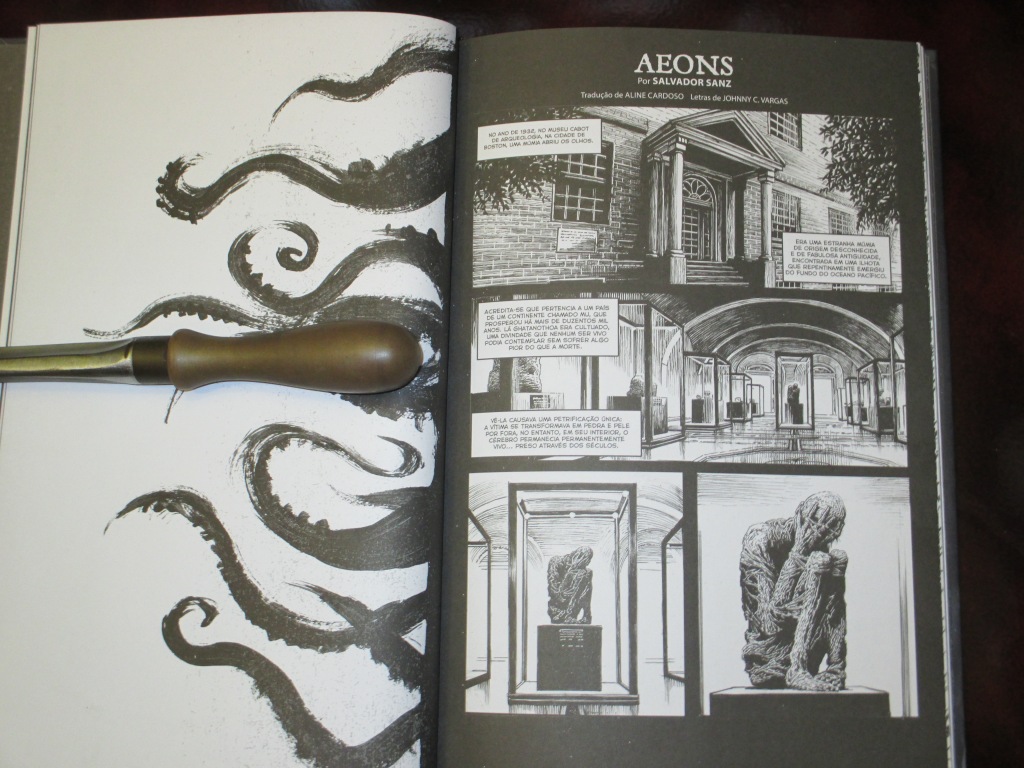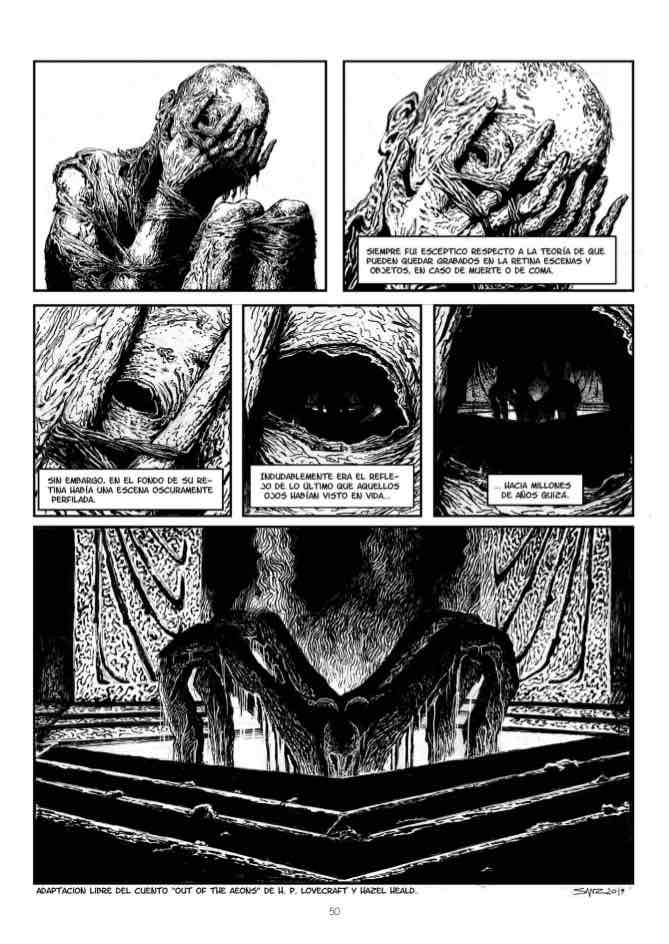Jewish folklore has preserved much of the terror and mystery of the past, and when more thoroughly studied is likely to exert considerable influence on weird fiction. The best examples of its literary use so far are the German novel The Golem, by Gustav Meyrink, and the drama The Dybbuk, by the Jewish writer using the pseudonym “Ansky”. The former, wildly popular through the cinema a few years ago, treats of a legendary artificial giant animated by a mediaeval rabbin of Prague according to a certain cryptic formula. The Dybbuk, translated and produce in America in 1925, describes with singular power the possession of a living body by the evil soul of a dead man. Both golems and dybbuks are fixed types, and serve as frequent ingredients of later Jewish tradition.
—H. P. Lovecraft, “Supernatural Horror in Literature” (1927 version),
Collected Essays 2.100
Gustav Meyrink was the pseudonym of Gustav Meyer, an Austrian who had lived in Prague for twenty years as a banker. In the 1890s Meyrink developed an interest in the occult, and became a member of the Hermetic Order of the Golden Dawn (and also, briefly, the Theosophical Society). In 1902 he was charged with fraud, which ended his banking career; Meyrink turned his focus to writing and translation, and became especially known for his German-language stories of the supernatural. While not Jewish himself, Meyrink’s close familiarity with Prague, including the Jewish quarter and the occult provided him the ingredients for his greatest novel.
Der Golem was serialized in the German magazine Die Weißen Blätter from December 1913 to August 1914; it was published as a standalone novel in 1915, to immense popularity. The book was eventually translated into English by Madge Pemberton, and The Golem was published in 1928. Of course, H. P. Lovecraft’s first version of “Supernatural Horror in Literature” was published in 1927…so how did he write about Meyrink’s novel?
He watched the film.
The one weird film I did see was “The Golem”, based on a mediaeval ghetto legend of an artificial giant. In this production the settings were semi-futuristic, some of the ancient gabled houses of Prague’s narrow streets being made to look like sinister old men with peaked hats.
—H. P. Lovecraft to August Derleth, 16 Dec 1926, Essential Solitude 1.56
You left out the “Golem” illustration mentioned, but I fancy you may send it later. I wish I could get hold of a copy of the book. I saw a cinema of it in 1923, but never had access to the Meyrink text–although I mentioned it in my article.
—H. P. Lovecraft to Robert Bloch, c. 6 Dec 1933, Letters to Robert Bloch & Others 92
Der Golem (“The Golem”) was a silent film directed by and starring Paul Wegener with German intertitles released in 1915. The film is now believed to be lost, aside from some fragments. This film was followed by two more: Der Golem und die Tänzerin (“The Golem and the Dancing Girl”) in 1917, and Der Golem, wie er in die Welt kam (“The Golem: How He Came Into The World”) in 1920, both of which were also directed by and starring Paul Wegener as the golem. So it isn’t clear which film Lovecraft actually saw. The 1920 film survives and is in the public domain.
Lovecraft claimed in most of his letters to have caught a showing of it in 1921, and like many an English student of the VHS era who needed to write a book report, he assumed somewhat erroneously that it was faithful to the plot of the book. However, despite being nominally based on Meyrink’s novel, the book and films share little in common save the Prague setting and the Golem legend—or at least, an interpretation of the original Jewish lore as filtered through several non-Jews. Meyrink’s novel recounts his version of the golem story in brief:
“The original story harks back, so they say, to the sixteenth century. Using long-lost formals from the Kabbala, a rabbi is said to have made an artificial man–the so-called Golem–to help rint the bells in the Synagogue and for all kinds of other menial work.
“But he hadn’t made a full man, and it was animated by a sort of vegetable half-life. What life it had, too, so the story runs, was only derived from a magic charm placed behind its teeth each day, that drew down to itself what was known as the ‘free sidereal strength of the universe.’
“One evening, before evening prayers, the rabbi forgot to take the charm out of the Golem’s mouth, and it fell into a frenzy. It raged through the dark streets, smashing everything in its path, until the rabbi caught up with it, removed the charm, and destroyed it. Then the Golem collapsed, lifeless. All that was left of it was a small clay image, which you can still see in the Old Synagogue.”
—Gustav Meyrink, The Golem (1985 ed.) 26
The German trilogy of films adapt a similar version of the golem story, in different times and contexts. The 1915 film has an antiques dealer discover the Golem of Prague and revives it to serve him; as in the original legend the Golem eventually goes on a rampage. The 1917 film is a comedy where a man makes himself up as the golem to win love. The 1920 film is essentially a retelling of the Golem of Prague legend, set in the medieval period. None of these make any effort to follow the original Jewish story very closely. Lovecraft, ignorant of Jewish lore as he was, probably had no idea how the film differed from the original Jewish story.
In Meyrink’s novel the Golem never plays an active role—it is a shadowy figure in a novel that is focused on the life of the mentally unstable Athanasius Pernath, as experienced by a nameless narrator; so that the story has something of an avant garde, experimental feel, with some chapters possibly being memories, delusions, or dreams and it is never quite clear what is the reality.
Lovecraft finally got a chance to read The Golem in 1935, when his young friend Robert H. Barlow loaned him a copy of the 1928 English translation. Having finally read it, Lovecraft’s acclaim was immediate:
Lately read Gustav Meyrink’s “The Golem”, lent me by young Barlow. The most magnificent weird thing I’ve struck in aeons! The cinema of the same title which I saw in 1921 was a mere substitute using the empty name—with nothing of the novel in it. What a study in subtle fear, brooding hints of elder magic, & vague driftings to & fro across the borderline betwixt dream & waking! There are no overt monsters or miracles—just symbols & suggestions. As a study in lurking, insidious regional horror it has scarcely a peer—doing for the ancient crumbling Prague ghetto what I have vainly tried to do for certain festering New England backwaters in some of my own laboured efforts. I had never read the novel before, but mentioned it in my article as a result of having seen the cinema. Now I perceive that I ought to have given it an even higher rating than I did.
—H. P. Lovecraft to J. Vernon Shea, 11 Apr 1935, Letters to J. Vernon Shea 266-267
But—I’ve read “The Golem!” Iä! Shub-Niggurath! The Goat with a Thousand Young!!! That’s what I call a story! Nothing like the cinema—the latter was just a shocker capitalising the title—though it did have splendid architectural effects. How splendidly subtle the novel is—no overt monsters, but vague suggestions of inconceivable presences & influences! It captures the nebulous, brooding horror of the immemorial Prague ghetto as I have feebly sought to capture that of certain ancient & retrogressive backwaters of New England.
—H. P. Lovecraft to R. H. Barlow, 20 Apr 1935, O Fortunate Floridian 251
Lovecraft was so enthusiastic about the novel that he encouraged several of his correspondents to write to Barlow to have the loan of the book; so that over the next few months it was duly sent from Lovecraft to C. L. Moore, to Margaret Sylvester, Duane W. Rimel, Emil Petaja, F. Lee Baldwin, and Richard F. Searight, and offered it to Clark Ashton Smith as well. A few of their thoughts on the novel survive:
You were right about “The Golem”. Reading it in broad day was no insurance against the subtle assaults upon reality. “No actual monsters jump out of its pages”, but even tho I read it on a sunny Sunday afternoon, in a deckchair in the sunshine, it left me cold and chilly inside, and a bit glassy-eyed. I remember so vividly having wakened somewhere in grey night and seeing dusty moonlight falling thru bars on just such a littered floor as P. awakened to see in the Golem’s room. I can’t have, of course, but the book is so vivid I do remember it clearly. It was ugly. I haven’t quite finished, but will forward it to Miss Sylvester soon, as Barlow has requested.
—C. L. Moore to H. P. Lovecraft, 7 May 1935, Letters to C. L. Moore 35-36
Thanks for Ar-Ech-Bei’s offer of The Golem. However, I read the book several years ago, when it was loaned to me, by a young friend in the Bay region. I agree with you that it is a most consummate and eerily haunting study in strange atmosphere; probably one of the best things of the kind ever written.
—Clark Ashton Smith to H. P. Lovecraft, Jun 1935, Dawnward Spire, Lonely Hill 608
The others in the lending-list no doubt made their own appreciative comments. As with Lovecraft’s discovery of William Hope Hodgson around the same time, the reading of Meyrink’s novel prompted Lovecraft to read more of his work…but the Old Gent was stymied by the general lack of English translations.
Glad “The Golem” reached you at last. I was sure you’d appreciate it—for it is really a phenomenal triumph in its way. Few books indeed are capable of summoning up such a poignant & convincing pageant of mystical atmospheric impressions—& the absence of conventional “conflict” is all in its favour. I wish I owned it—but am told it is hard to get despite the relatively recent date (1928) of this translation. The original German novel, I believe, dates from the 1890’s. I wish I knew something of Meyrink, but I have found almost nothing about him. The only thing of his besides “The Golem” that I’ve read are som rather mediocre short stories—one of which appeared in W. T. I believe he is still living—but doubt if he has written or ever will write anything to compare with this early tour de force.
—H. P. Lovecraft to Richard F. Searight, 19 Nov 1936, Letters to Price & Searight 431
Although Lovecraft didn’t know it, Meyrink had died in 1932. In his letters, Lovecraft says he had read “a story in the ‘Lock & Key Library'” (ES 2.691), which would be “The Man on the Bottle” (Lock & Key Library vol. 3, 1909), which Lovecraft later described as “a rather clever but essentially routine conte cruel” (OFF 259); “I recall “Bal Macabre” in Strange Tales—very effective, with genuine atmospheric tension” (OFF 259), “Bal Macabre” was published in Strange Tales of Mystery and Terror (Oct 1932); and finally “The Violet Death” ran in Weird Tales (Jul 1935)…and with that, Lovecraft had read basically all of Meyrink’s work that had been published in English during his lifetime.
It is easy to see why Lovecraft was so enamored of The Golem; in its style and elements it is almost a Lovecraftian novel, with is tenuous sanity, hinting horrors, the strange mystical book Ibbur, and other elements. While it would be interesting to ruminate on the influence The Golem had one Lovecraft’s own fiction—to draw parallels, perhaps, between the original Jewish legend of the artificial servitor run amok and the shoggoths of At the Mountaints of Madness—but by the time Lovecraft had read the novel he had relatively few works of original fiction left to write, and those works show little influence of the book or Meyrink’s style. Still, this novel if nothing else would have introduced Lovecraft to tarot cards,which are a recurring occult element.
There was, in fact, only one thing left to do: revise “Supernatural Horror in Literature” to rectify his earlier mistake.
I didn’t change as much as I expected—words here & there, a bad punctuation style where dates follow titles of stories, a boner regarding “The Golem”, & a bit of over-florid writing in the Poe chapter. To explain that Golem business I must confess that when I wrote the treatise I hadn’t read the novel. I had seen the cinema version, & thought it was faithful to the original—but when I came to read the book only a year ago…Holy Yuggoth! The film had nothing of the novel save the mere title & the Prague ghetto setting—indeed, in the book the Golem-monster never appeared at all, but merely lurked in the background as a shadowy symbol. That was one on the old man!
—H. P. Lovecraft to Willis Conover, 31 Jan 1937, Letters to Robert Bloch & Others 415
The revised portion of the essay now reads:
Jewish folklore has preserved much of the terror and mystery of the past, and when more thoroughly studied is likely to exert considerable influence on weird fiction. The best examples of its literary use so far are the German novel The Golem, by Gustav Meyrink, and the drama The Dybbuk, by the Jewish writer using the pseudonym “Ansky”. The former, with its haunting shadowy suggestions of marvels and horrors just beyond reach, is laid in Prague, and describes with singular mastery that city’s ancient ghetto with its spectral, peaked gables. The name is derived from a fabulous artificial giant supposed to be made and animated by mediaeval rabbis according to a certain cryptic formula. The Dybbuk, translated and produced in America in 1925, and more recently produced as an opera, describes with singular power the possession of a living body by the evil soul of a dead man. Both golems and dybbuks are fixed types, and serve as frequent ingredients of later Jewish tradition.
—H. P. Lovecraft, “Supernatural Horror in Literature”
While this passage shows how scanty was Lovecraft’s knowledge of Jewish religion, history, and lore—he once commented about The Golem, “There is nothing about the Chassidim in it—but the atmosphere is rich enough without ‘em.” (LPS 427), because after his encounter with The Dybbuk (1925) he associated Hassidic Jews with Jewish occultism—the episode as a whole shows that Lovecraft was able to digest and appreciate material from varied traditions, even if his understanding was incomplete. He never, for example, shows any awareness that Meyrink was not Jewish, or that Meyrink’s depiction of the golem legend was influenced by non-Jewish esoteric traditions. While it would be difficult to say that The Golem substantially influenced his fiction in any way, Lovecraft certainly seems to have though it enriched his life—and he made an effort to share that experience with the younger writers he associated with.
Thanks to Cora Buhlert for pointing out that I should mention the 1917 and 1920 film.
Bobby Derie is the author of Weird Talers: Essays on Robert E. Howard and Others and Sex and the Cthulhu Mythos.
Deep Cuts in a Lovecraftian Vein uses Amazon Associate links. As an Amazon Associate I earn from qualifying purchases.






































